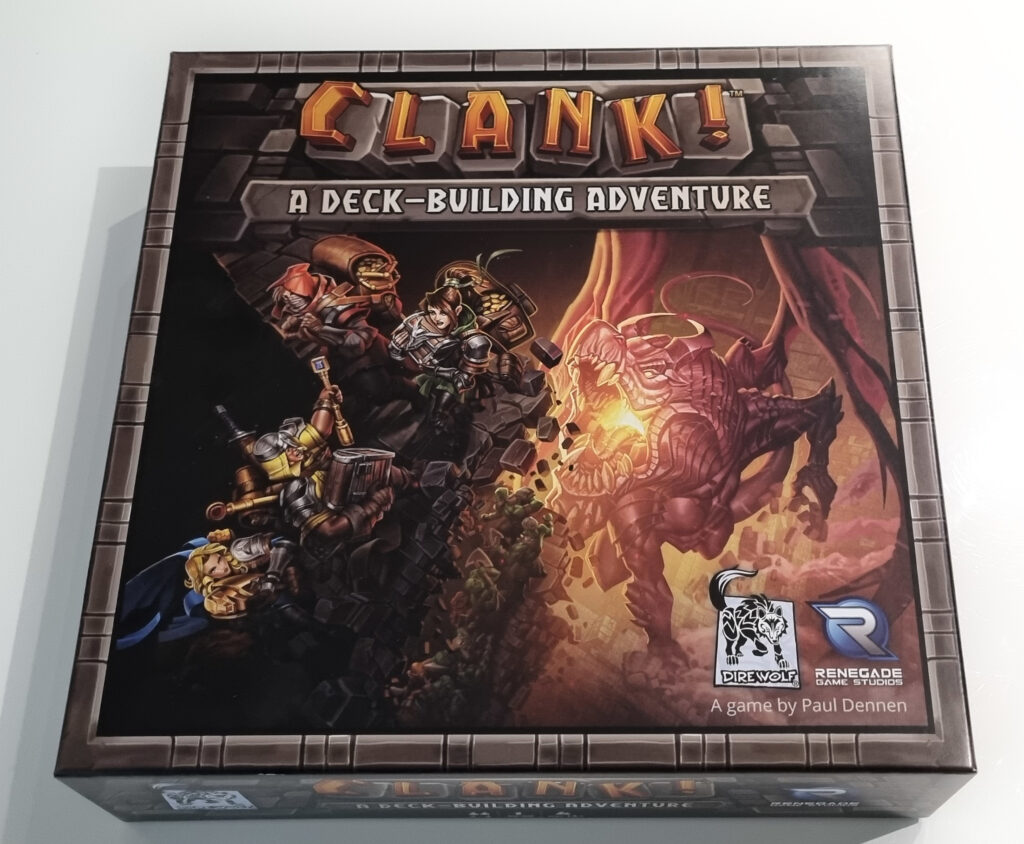Basic information:
- Genre: strategy, deck-building
- Duration: Box says 30-60 min, really 30-45 min per player
- Player count: 2-4
- Released: 2016
- Age limit: 12+
Clank! (full name Clank! A Deck-Building Adventure, henceforth known as Clank) is exciting in concept. At its core, it is a deck-building game where cards are used to move the pawns in traditional board game style on a board. Players are thieves tasked with sneaking into the dragon’s lair to collect treasures. The player who has collected the most loot is the winner. Don’t wake the dragon though…
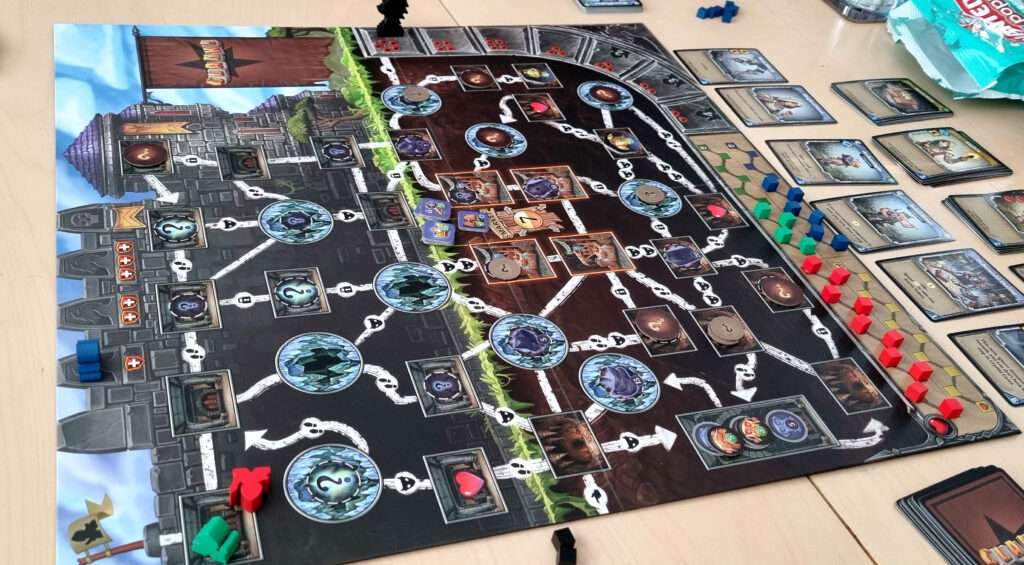
Gameplay
On their turn, players play all the cards from their hand. This is already a slightly different idea to deck building games, because usually in similar games you don’t have to play all your cards. The cards then have different texts and symbols, and everything is resolved in the order the player wants. Let’s quickly go through the different functions the cards have:
- Skill
- Used to get new cards from the store which is accessable by all players
- Shoe
- Used to move
- Every shoe allows to move one space on the board (excluding some exceptions)
- Sword
- Used to bash monsters in hopes of rewards or to avoid damage coming from the board
So, in practice, cards are used to buy, move and kill. Then there is one more essential thing that happens when playing cards. Making sound. If the card says that you make a sound (“+1 Clank” as the game name hints), you should insert one cube to wait for the dragon to attack. The dragon attacks when the shop is filled with new cards to buy, and if any such card has a dragon image on it. The attack takes place so that the sounds produced by the players (=cubes) are added to a bag from which a certain number of cubes are drawn. If a cube with a player’s color is picked up, they take 1 damage. This is a really exciting mechanic!
The board consists of three different sections: the surface, the beginning of the cave and the depths. The final stage of the game starts when one of the players returns to the surface from the dungeon. This can only be done when you have retrieved one larger treasure, i.e. an artifact. During the turns of the player who got out in the final phase, the dragon always attacks. If after a few turns from the start of the end phase, some players have not reached the surface of the earth, they die. On the other hand, death is not always so serious, because if you happen to die in the beginning of the dungeon, you can still participate in the points count. According to the story, the nearby villagers will then drag you out of the dungeon, which is a really fun little fact.
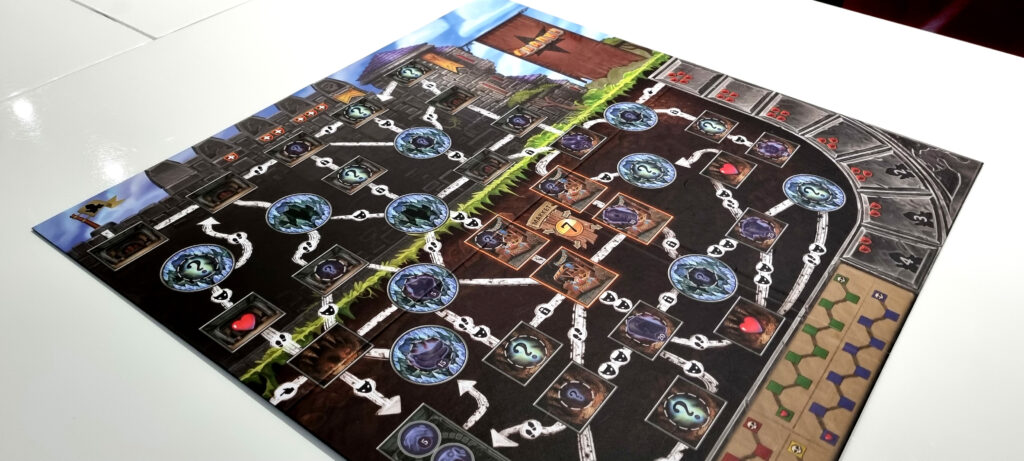
Then to the review phase itself. First of all, I have to say that the game is really nice to play. The game progresses in a relatively straightforward way, as you don’t always have to think very carefully about the order in which the cards must be played. In addition, moving around the board is surprisingly natural for such a deck building mechanic. This cooperation of the board and deck building was what I was the most worried before my first game. It works well.
Based on my multiple playthroughs, I can also say that the dragon mechanics work well. It’s always exciting to watch when a dragon attacks whose cubes are taken and who gets damage. Also, the fact that everyone basically has to put cubes in the bag at regular intervals keeps the situation even.
However, the previous praise leads to one bad thing about Clank. Luck plays a relatively large role in the game. The dragon may attack the same player all the time, so they have to act very carefully for the rest of the game. It can also be that with one attack one of the players takes significantly more damage than the others. For example, in my last playthrough, I risked one round before returning to the surface of the earth, and I got 5 damage from the attack, which was enough to kill me. Another example of the effect of luck is the cards drawn from the deck. For example, if you needed shoe symbols from the cards to move, and you don’t get any wanted symbols, it could be that your round is wasted. At this point, someone will probably complain that the player in question has bought bad cards in his deck and thus built it badly. This may be true, but no matter how well you build your deck, a round can go completely wrong due to luck.
Besides luck, another potentially bad thing about the game is its duration. After all, the game moves to the final stage when one of the players moves to the surface. To be able to do this, one treasure had to be retrieved from the dungeon. The nearest such treasure is relatively close to the surface. If one of the players decides to just pick it up and return to Earth, the game is really short. Of course, this doesn’t guarantee them a win (they’ll probably lose), but in a few of our games I’ve had the early feeling that the game is getting close to the end. Maybe the game could use a mechanic that would force you to explore the dungeon until you find a certain thing that is randomly hidden in the dungeon. In this case, a player cannot end the game by going to the nearest treasure and that’s it.
Components
In general, the components of the game are of really good quality. The cards are not the cheapest material that tears and wears at the corners, which is a really good thing in a game where decks are shuffled relatively often. Tokens are made from basic cardboard.
The illustrations on the cards are good and a lot of effort has been put into the different cards. The board also looks great and is really vibrant. On the other hand, I don’t like the illustration of the game box, because I think it doesn’t reflect the other graphics and atmosphere of the game well.
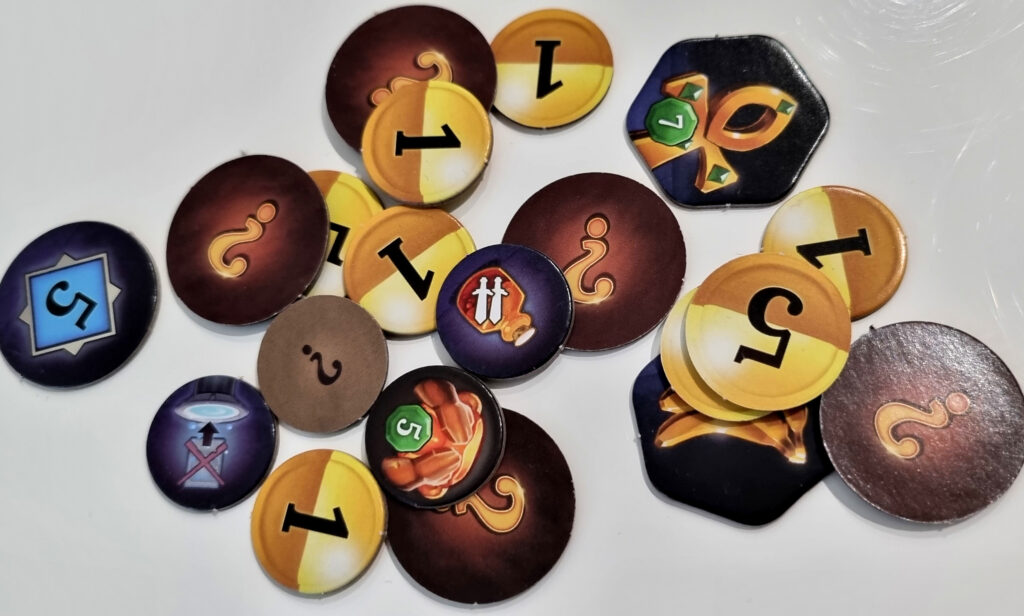
The instruction manual is written in a little bit too confusing a fashion for my own taste. Reading it makes sense the first time you read it, but after that it can be difficult to find some small information there. The rules themselves are really easy, which I appreciate. The game is really easy to teach new players, even though at first it seems that the game has a lot of all the little details. So, even though the rules are a bit loosely written, you learn the game quite well after reading them.
Replayability
Replayability is one of the best aspects of the game. There are two boards in the game: one for beginners and one for experienced players. This has at least been enough to keep interest up over multiple playthroughs. Even though I’m already relatively familiar with the beginner’s board, I’ve still taken a slightly different route every game round, and every round has thus been different. Collectable secrets that randomly dot the board also increase the replay value when things are not always laid out the same way on the board.
The cards also deserve a special mention. There are really a lot of different ones, which makes the decks of players different from each other. Of course, there are several copies of some of the cards available in the shop deck, but the shop deck is really thick. Thus, the probability of the same cards rotating in the store is small. The cards themselves also do a variety of different things, which adds to the deck variations.
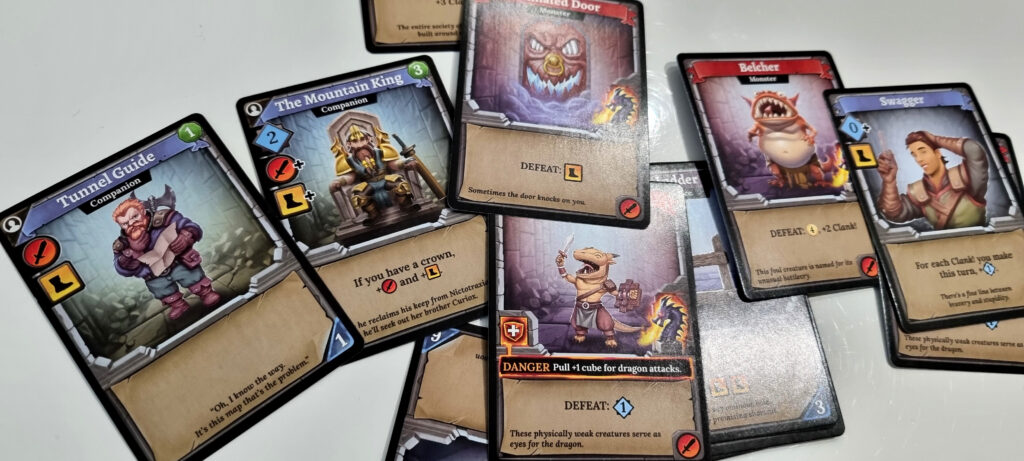
Summary
Clank! is one of my recent favorite games. It’s always nice to play. The game is easy to learn and teach, which makes it easy to play with different players. In addition, you don’t always have to learn the rules all over again due to them being so simple. The mechanics of the game work, the game looks nice and after several playthroughs I always feel that I find something new in it and no playthrough is the same. The effect of luck on the game and its potential shortness slightly penalize the game from full points, but if you can forget these, the game is really bueno!
PROS
- “Deck-building + board” combo works well
- The dragon mechanic is exciting
- Looks great visually
- Lots of different cards which makes the game highly replayable
CONS
- The game can be super short based on the players’ actions
- Luck plays a fairly big role

